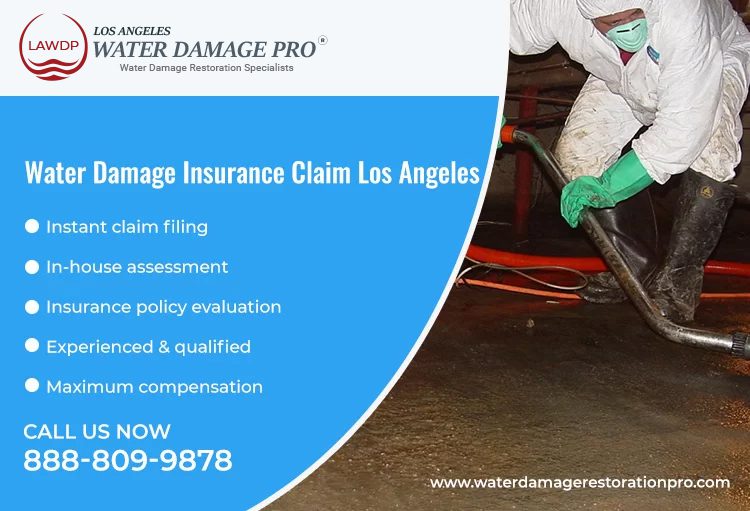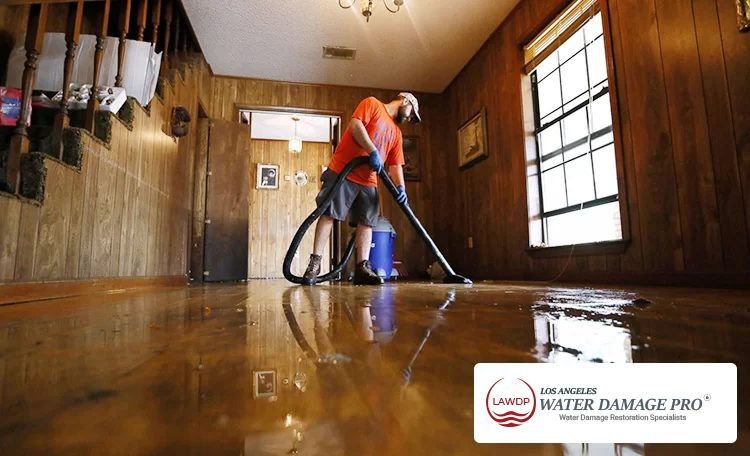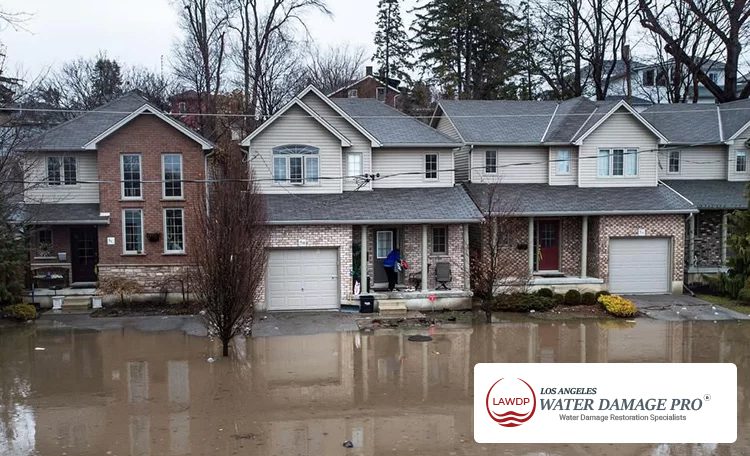- 24/7 Water Damage Emergency
- Licensed and Insured
- FREE Estimates
- Direct Insurance Billing
- Insurance Claims
Water damage is the second most common cause of homeowners’ insurance claims after wind and hail damage. According to the Insurance Information Institute, about one in 50 insured households has a property damage claim from water damage each year. Hence at least a working knowledge as regards Los Angeles water damage insurance claim is a must.
Many water damage claims are relatively small and easy to handle. Large or complicated claims, however, can be a nightmare!
This is often the case when you do not fully understand your insurance policy and are unable to negotiate with an experienced insurance adjuster. And if you have time constraints and are not used to dealing with contractors, you may be in for a rough ride.

If the cause is abrupt and accidental, the majority of homeowners’ insurance policies will normally cover water damage. This may sound simple and straightforward, but as the saying goes, the devil is in the details.
Let’s look at two examples.
Homeowners’ insurance policies typically cover water line breaks. However, this is not definitive, such as when the water line has been leaking for a long period of time.
Most home insurance policies limit water damage coverage to water that has not entered your home from the ground or sewer. Keep in mind that you can get sewer overflow coverage from most insurance companies for an additional fee.
Mold is often a consequence of water damage. So will you get mold coverage by your homeowner’s insurance? It is not always an easy question to answer. It usually depends on what caused the mold.
You will get mold coverage if it can be directly linked to a covered event. But if the homeowner did nothing to prevent the mold or allowed it to get worse, it’s unlikely to get covered.
Many homeowners think of water damage as including damage from a flood. This is a popular misconception.
Flood damage is not usually covered by homeowners’ insurance. If you want to have flood damage insurance, there are specific flood insurance policies available.
According to the Federal Emergency Management Agency (FEMA), flood damage includes the following:
“A general and temporary condition of partial or total flooding of 2 or more acres of normally dry land or of 2 or more properties (at least 1 of which is owned by the policyholder) from:
Collapse or subsidence of land along the shore of a lake or a similar body of water as a result of erosion or undermining caused by waves or currents of water that exceed anticipated cyclical levels resulting in a flood as defined above”.
This definition is a good place to start if you want to assess whether your water damage will be attributed to a flood and whether you will get coverage or not.

As a property owner, you are responsible for maintaining your property and taking steps to prevent or reduce the risk of water damage.
The first thing to do when you notice a potential water damage event is to mitigate the damage. The longer an area remains wet, the greater the chance that damage to the area will worsen and spread to surrounding areas. You may need to hire an emergency drying service company to help you.
Note: Do not dispose of any item that has sustained water damage. Most policies require damaged items to be available for inspection. This makes it simpler for your insurance provider to determine the value of the damaged goods.
While all policies are different, most insurance companies require that the company be notified immediately. This means that if you have experienced water damage, you should notify your insurer or agent immediately. Additionally, you should file your claim as quickly as possible to avoid a breach of your insurance policy, which could result in your claim being denied.

You come home from vacation to find a small pond that has materialized in your basement. Your reaction: how to get insurance to pay for water damage. Take a breath and avoid panic. The actions listed below are meant to be helpful.
If you’re sure it’s safe to do so, take immediate steps to prevent more water from flowing where it shouldn’t. This could mean turning off your home’s main valve (often requiring a wrench) or an individual water supply valve, also known as a “stop.”
Stoppers leading to your dishwasher, toilet, washing machine, or ice maker can usually be closed (clockwise) by hand to stop the flow of water.
Water damage was the cause of almost one in four home insurance claims in 2018. Between 2014 and 2016, the number of water damage claims in the US actually exceeded the number of losses caused by fires and hurricanes. What do these numbers mean? Water damage is quite common. But not all types of water damage are covered by a typical homeowner’s policy.
As a general rule, water damage is covered by home insurance if it is sudden or accidental. Water damage is not covered when it is the result of poor maintenance/neglect in the home (for example, a roof that has not been repaired in 30 years). Flood damage is also not covered (unless you have a separate policy for flood insurance).
Water damage is generally covered by home insurance:
Water damage is usually not covered by home insurance:
Time is of the essence when it comes to water damage. According to FEMA, mold and mildew can begin to grow 24 to 48 hours after exposure. So if your pipe bursts on Friday night, don’t wait until Monday morning to let your agent/insurance company know what’s going on. Most carriers operate round-the-clock hotlines that can assist you with filing claims and offer cleanup suggestions.
Unless you can thoroughly clean and dry the area on your own, it makes sense to contact at least one water damage/restoration company. Insurance companies may not be willing to recommend a specific water damage company, but they should be able to help you identify several local options to choose from.
A water damage/restoration company is often required to pump out standing water and thoroughly dry any surfaces before moisture or mold can spread. If mold is already present, the water damage/restoration company may need to apply special cleaning solutions, after sealing and ventilating the damp area.
In severe cases, water damage can lead to unsafe or unsanitary living conditions inside your home. Large floods can bring household chemicals or sewage into the mix, which shouldn’t happen and can be easily overlooked. The risk of electrocution may be present. And even after standing water clears, mold spores can still pollute the air.
If you suspect any of these issues are at play, ask your water damage restoration company for advice on the safest course of action.
Your home restoration team will likely take photos of the damaged area, but you should take your own. (If you later decide to cut ties with this company, you don’t want to be chasing them for documents.) You should also take pictures of any items that need to be cleaned or replaced.
The loss from water damage extends beyond the items that become wet. Items in drawers or cabinets where mold has spread should also be professionally cleaned. You may be entitled to a refund for those expenses.
The insurance provider will dispatch an adjuster to your house as soon as practicable. He or she will assess the damage, take photos, and take measurements.
The damage’s cause and timing will also be discussed during the adjuster’s inquiries. His goal is twofold. First, trying to estimate how much it will cost to repair the damage and second, looking to determine if someone was at fault.
At some point after your assessment, your adjuster will send you a written estimate of what they think it should cost to repair your damage. He will probably create an item list for labor and materials (drywall, paint, mortar, tile, etc.). Depending on the size of the claim, he may also write a check for all or part of this amount, so you can get started on repairs.
But just be prepared; that settlement figure may seem a bit low. Unless your home insurance policy was written to provide “replacement cost value,” your estimated total will likely be based on an actual cash value or ACV. ACV represents the current value of your property, not what you paid for it or what it would cost to renovate.
For small claims, negotiation may not be a problem. But larger projects often present challenges, in terms of lining up your adjuster and contractor. This is where your public adjuster can be a resource.
If you don’t have the stomach to haggle over these issues, ask your public adjuster to do the work for you. He or she has more experience with this process and knows how to frame the case you are trying to present.
It is essential that you have all the documents ready when you are filing for water damage insurance. Here are some of the most important documents that you need.
| Document | Issued By |
| Insurance policy | Insurance company |
| Claim form | Insurance company |
| Proof of ownership/occupancy | Property owner/occupant |
| Photos of the damaged area | Property owner/occupant |
| Receipts/invoices for repairs or replacements | Property owner/contractor |
| Police report (if applicable) | Local police department |
| Flood zone determination (if applicable) | Federal Emergency Management Agency (FEMA) |
These are some of the main reasons why it is smart to hire a public adjuster:
Handling a large or complex water damage insurance claim in Los Angeles on your own can be challenging. There are many complexities that you may not be aware of and that can cost you dearly. You can find yourself immediately bewildered and out of your element.
A good public water damage adjuster has the knowledge and experience to handle your homeowners’ insurance claim on your behalf. We consistently work for you.
Dealing with a large or complicated water damage insurance claim can be time-consuming. It can feel like a second full-time job. Letting a public adjuster manage the process on your behalf will save you a lot of time. And it’s comforting to know that your claim is in good hands.
Negotiating with the insurance adjuster that has been appointed by your insurance company can be difficult. They act in the best interest of the insurance company, not in your best interest.
Public adjusters generally work on a contingency basis and our fees are based solely on a percentage of the settlement amount. This motivates us to work hard to get you the best possible offer on your insurance policy in the shortest amount of time.
If you have suffered water damage to your home, you want your insurance claim and repairs finished as soon as possible. Public adjusters deal with insurance claims on a daily basis. We know how to quickly organize and submit the correct documentation to support your claim.
Whether you received a bad settlement offer or don’t have the time and experience to manage your claim and deal with contractors, a public adjuster can help.
Unlike corporate insurance adjusters who work for large companies, public adjusters work on behalf of you, the policyholder. We are not affiliated with the insurance provider. The only time we contact the insurance company is when it comes to the policyholder’s insurance claim.
Water Damage Restoration Pro shall help you settle all your water damage restoration claims at the earliest in a hassle-free manner.
It is to assess the damage and start working on the restoration process ASAP. Any delay can result in structural weakness, rot, rust and other damages to the walls and home interiors. At the same time you can hire a public adjuster for helping in filing a claim with your company.
Well, to be more precise, flood insurance is not covered under the homeowner’s insurance policy. It has to be a separate flood insurance policy with additional premium. However, some of the consequences of flooding may not be covered by the specific insurance policy.
To be precise, any kind of water damage related to hail, rain or snow, is actually covered under your homeowner’s insurance policy. Generally, for all kinds of water damage to the roof, house interiors & exteriors, you can file an insurance claim with your service provider.